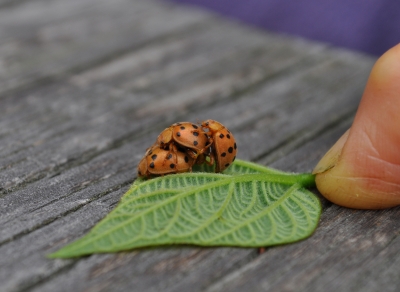WEEDS, BIRDS, & PEST-FREE CURRANTS
/0 Comments/in Fruit, Gardening, Pests/by Lee Reich
I Battle Weeds and Birds, but Currants are Care-free
Part of my weedless gardening technique (which I thoroughly fleshed out in my book Weedless Gardening) involves — sad to say, for some people — weeding. After all, no garden can ever be truly weedless. Even people who spray Roundup eventually get weeds as they inadvertently “breed” for Roundup-resistant weeds, which now exist. My techniques are weed-less rather than weedless.
Which brings me to hoeing. Most years my hoe rests on its designated hook in the garage. This year, it’s hardly made it back to garage, mostly just leaning up against the garden fence alongside the gate. “And why is this?” you might ask. The answer is rain. This season, rainfall has been dropping in sufficient amounts at regular intervals, all of which has coaxed good plant growth, including that of weeds.
More importantly, the rainfall has promoted plant growth in paths and between widely spaced plants. One leg of my 4-legged “weedless gardening” stool calls for drip irrigation, which pinpoints water near plants. In a normal year, or a dry year, there’s little moisture to spur on weed growth elsewhere. This year, rainfall has democratically spurred weed growth everywhere.
Hence the hoe. The best hoes to snuff out young weeds without unduly disturbing the ground are ones with thin, sharp blades that lie parallel to the ground. All that’s needed is to slide such hoes back and forth a quarter of an inch or so beneath the surface, cutting the stems of hopeful, young interlopers. The work, if can be called that, is quick and easy, not calling for the “iron back with a hinge in it” recommended for a gardener by Charles Dudley Warner in his 19th century classic My Summer in the Garden. Too many people use a pull or draw hoe, whose blade lies perpendicular to the handle, to try to conquer weeds.
The hoes I’m recommending are so-called push or thrust hoes. Some examples include the collinear hoe, the scuffle hoe, the stirrup hoe, and, my favorite, the wingèd weeder. With any of these hoes, roots aren’t damaged and lower depths of soil remain at lower depths so that inevitable weeds seeds buried there are not awakened as they are exposed to light. (Minimal soil disturbance is another leg of my 4-legged “weedless gardening” stool.)
Still, my wingèd weeder is not effective unless it is used — frequently this season, ideally once a week or within a couple of days after a rain. Used in a timely manner, the wingèd weeder does a quick, effective, and satisfying job.
Currants are an Old-Fashioned Fruit Easy to Grow
“The currant takes the same place among fruits that the mule occupies among draught animals—being modest in its demands as to feed, shelter, and care, yet doing good service,” wrote a nineteenth-century horticulturalist. Hoeing takes time, especially this year, so it’s nice to balance that with something — currants, in this case — that is “modest in its demands.”
One of my currant bushes, a Perfection (that’s the variety name) red currant, splays its stems upward and outward in an ornamental bed in front of my house. Sharing that bed, for beauty and for good eating, are huckleberries, lowbush blueberries, and lingonberries, and, for beauty alone, mountain laurels and dwarf rhododendrons.
 The only care my currant gets is, anytime from November until late March, pruning. The plant bears best on 2- and 3-year-old stems so I cut away anything older than 3 years old and reduce the number of new, 1-year-old stems to the half dozen or so most vigorous ones. The whole bed gets a sprinkling of either soybean meal (1# per hundred square feet) or alfalfa meal (3# per hundred square feet) in late fall, topped with a mulch of leaves or wood chips.
The only care my currant gets is, anytime from November until late March, pruning. The plant bears best on 2- and 3-year-old stems so I cut away anything older than 3 years old and reduce the number of new, 1-year-old stems to the half dozen or so most vigorous ones. The whole bed gets a sprinkling of either soybean meal (1# per hundred square feet) or alfalfa meal (3# per hundred square feet) in late fall, topped with a mulch of leaves or wood chips.
The bush began bearing towards the end of June and a few clusters of the plump, jewel-like fruits still hang from the branches. Most people use red currant for jelly or sauce. I like to eat them straight up, with my morning cereal, for instance. The flavor is tart early on but has mellowed by now.
Currants were once a more popular fruit in America, and especially here in the Hudson Valley. They are one of the few fruits that tolerate shade (and deer!), and were often grown in the shade of large, old apple trees. Local folk, including children, would ride out to the orchards in hay wagons for communal picking.
Currant is, truly, among the uncommon fruits for every garden (good book title, that).
I Reluctantly Share Some Blueberries with Birds
Just a quick note about my blueberries, which are also relatively carefree. Last year’s abundance of cicadas may have upped bird populations, or at least made birds believe that lots of food would always be in the offing. Not so, birds. Perhaps, then, that’s why so many bird are fluttering all around my blueberries, mostly on the outside of the net that encloses my Blueberry Temple of 16 plants.
Right now a hawk — a cardboard one, swooping in breezes as it hangs from a string fixed to the end of an long, inclined bamboo pole — is meant to dissuade birds from even approaching the net. Calm mornings keep the hawk still enough so an occasional bird find their way through the net (where?) to venture into the Temple.
Eerie White to Golden Flowers, with Some Fungi Helping Out
/3 Comments/in Design, Gardening, Soil/by Lee ReichWhite Indian pipes, mycorrhizae, and a golden flower
I do occasionally tear myself away from the farmden. So into the woods I went last Friday and as I was hiking along and glancing down at the trail, I came upon one of my favorite flowers. It’s a favorite not for its beauty but for what it hints at of goings-on beneath the soil surface.
The flower was indian pipes, Monotropa uniflora, an eerily white plant that looks like a upright tobacco pipe whose stem has been poked into the ground. Yes, it’s white. All white. You might rightly wonder how the plant synthesizes carbohydrates for energy and for structure. Photosynthesis, which makes carbohydrates, requires chlorophyll, which is green. Indian pipes don’t need chlorophyll because they get their carbohydrates from neighboring trees.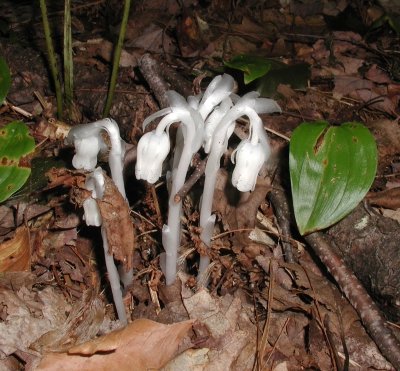
Join me while I go below ground. Stopping for a look at the roots of indian pipes, we see that they are infected with the fine threads of fungal hyphae. Now, if we follow the fine threads of the fungal hyphae out of the roots and through the soil, we eventually come to the roots of a nearby tree whose roots also are infected by one and the same fungus. A continuous connection exists from the tree to the fungus to the indian pipes.
The tree does have green leaves and, as with other plants, some of the products of its photosynthetic labors are channeled down to its its roots. Some of those products travel out the roots and into the fungal hyphae, and some of that is drawn out of the hyphae into the indian pipes for the latter’s sustenance and growth. Sounds like a one-sided relationship, a pretty good deal for the indian pipes. It is. The plant is a parasite, taking but offering nothing in return.
The relationship between the fungus and the tree, however, is symbiotic and called mycorrhizae (my-co-RYE-zay, which means fungus-root). Yes, the fungus sucks up some of the tree’s photosynthates, but in return it sucks up nutrients from the soil, then channels them back to the tree’s roots. The network of fungal hyphae in the soil is much more extensive than that of the roots, so, with fungal hyphae as “extenders,” the effective volume of soil “grazed” by roots is increased. Mycorrhizae are especially important for uptake of nutrients such as phosphorus, which roots (or their fungal extenders) must go out and find because it moves but little in the soil.
Myco . . . say what?
Wouldn’t mycorrhizae spur growth of garden plants? Yes. But look out your window; most of the plants you see are naturally mycorrhizal already. Still, deliberate inoculation might benefit young transplants. You can purchase inoculum, but the problem is that purchased inoculum often is not of fungal species best adapted to a particular location.
A better approach would be to keep your indigenous fungi happy. Limit tillage, which discombobulates the hyphae, grow a variety of plants, especially those that form mycorrhizal associations, and avoid pesticides. Also limit phosphorus fertilizers because they suppress mycorrhizae.
Another approach would be to grow your own mycorrhizal inoculant of local fungal species. Basically, you mix up a big batch of potting soil that has some indigenous soil in it and is not too high in nutrients. In this potting soil you grow a suitable host plant. (Not spinach, beets, or any plant in the cabbage family, none of which ever form mycorrhizae.) After the host plant dies at the end of the season, what’s left in the pot is indigenous fungal inoculum that can be added to a potting soil for growing seedlings. For more details, see http://rodaleinstitute.org/a-complete-how-to-on-farm-am-fungus-inoculum-production/. I use garden soil and compost in my potting mixes and assume there’s sufficient inoculum already present.
Grow Some Gold
As I rounded the bend at the back of my garden after my woodland hike, I came face to face with a flower I had planted temporarily back there, giant knapweed (Centaurea macrocephala), also known as Armenian basket flower, globe centaurea, and yellow hardhat. Plants with too many common names are usually suspect to me, and none of this plant’s names have a particularly nice ring to them — yet this plant is a showstopper.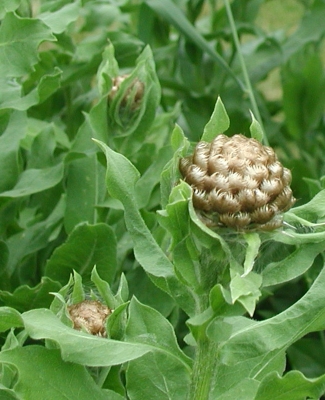
From the whorl of rather coarse leaves at the base of the plant rises a sturdy flower stalk. At almost 4 feet high, a big fat bud forms atop the stalk, a bud that looks like a globe artichoke that has been gilded. Nice enough even then, but a couple of weeks later — which is now — a bottlebrush of lemon yellow petals spills forth from the top of the bud.
Globe centaurea, the name most euphonious to my ears, tolerates heat and cold (USDA Hardiness Zones 3 to 8), and is relatively carefree. No need to prop the flower stalk up with a stake. The blossoms put on their show for about a month, not counting the gilded opening act, and hold up well as cut flowers, or can be dried.
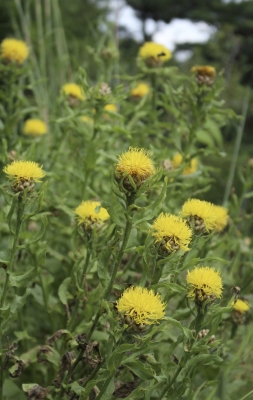 Globe centaurea deserves more attention over much of the country, except perhaps in the Pacific Northwest, where it’s considered invasive. I grew it years ago, and it disappeared. Nice to have it back.
Globe centaurea deserves more attention over much of the country, except perhaps in the Pacific Northwest, where it’s considered invasive. I grew it years ago, and it disappeared. Nice to have it back.
Plagues Come & Go, With Some Help, and Seattle-time
/10 Comments/in Fruit, Gardening, Pests/by Lee ReichMeet me in St. L . . . Seattle
Come hear me lecture on August 10, 2014 on “Luscious Landscaping, with Fruiting Trees, Shrubs, and Vines” at 1 pm in the Garden Room at Magnuson Park. For more information, go to http://www.brownpapertickets.com/event/755459.
Plague again; keep calm
Every year it seems some new plague is ready to attack plants. A few years ago, late blight of tomato moved to the fore. Emerald ash borer, threatening ash trees, was first found on our shores in 2002. (Figuratively; literally, the insect, native to Asia, was first noted in Michigan.) What’s next?
Perhaps a calmer outlook is called for. A decade or so garlic mustard seemed ready to take over our world. Not so, now, perhaps because it’s being crowded out by Japanese stilt grass, which itself seems now ready to take over our world. Garlic mustard is native over much of the northern hemisphere, except North America, and was introduced here around 1860 as a culinary herb. As for stilt grass, it hitchhiked here from China about a century ago, as packing material for porcelain. It’s deer-resistant, for what that’s worth.
Plant problems come and go. The best approach is to keep calm and, in some cases, plant something different, something plague resistant.
Bean Beetle Management
Green beans are a mainstay of my garden, of just about every garden. More than 20 years ago, Mexican bean beetles (a species of ladybug!) found my bean plants and have plagued them every year since.
The adults, with eight black spots over a red or yellow background, wake up late from winter sleep to lay eggs on bean leaves. I’ve come to despise the yellow, balled up spiny larvae that gorge on leaves and other plant parts.
Still, I have managed to grow good crops of beans over the years, not by killing the beetles or their larvae, but by growing a different plant. Sort of. Rather than grow pole beans, which reside in the garden all season long to provide a constant source of beetle food, I have been planting successive crops of bush beans. Bush bean plants tend to bear quickly and for about 3 weeks, then peter out, so a new planting in a new bed goes into the ground every 3 weeks from mid-May until late July.
Yield from a planting tapers off just as its resident beetle population is beginning a feeding frenzy. Then it’s time to pull up the plants, thoroughly clear the bed of leaves and old pods, and rush it all to the compost pile. Chopping the debris with a machete and burying it beneath straw and manure, and watering the pile, as needed, sends the temperature soaring, killing most of the beetles. Bean beetles are good fliers, so cooking the beetles in the compost pile doesn’t solve the problem, just keeps it under control.
Death to the beetles, with restraint
Something strange happened this year: As of this writing, only one beetle larvae has been seen. Last year I doused the bean plants a few times with one of two organic sprays, which gave good beetle control. It also gave me the confidence to try growing pole beans, as I did in my pre-Mexican bean beetle days. They got some bean beetles but we did harvest pole beans.
The sprays were Entrust and Azamax, both approved for organic agriculture. The active ingredient in Entrust is spinosad, a compound found in bacteria, Saccharopolyspora spinosa, that was isolated from soil collected inside an old rum still in the Virgin Islands. Although toxic to a range of insects, it is otherwise relatively benign. Still, the label requires waiting at least 3 days to harvest after spraying.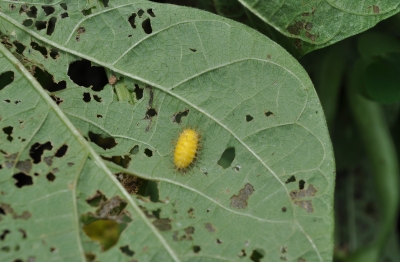
Azamax is an extract of the seed of the tropical neem tree, native to the Indian subcontinent. In that part of the world, this one tree has been used as human food, insect repellant, bird repellant, and an ingredient of soap. It degrades rapidly in soil or in water, and is harmless to earthworms, honeybees, and insect predators. Food crops can be harvested right after spraying Azamax.
Still, Azamax and Entrust are pesticides. Perhaps the bean beetle cycle has been broken here and sprays can be forgone in the future. I’ll keep calm. No sprays this year, yet.
SWD, go away
The same two organic sprays might be called upon for another pest, the spotted wing drosophila, unaffectionately known as SWD. Also an Asian import, this one has moved east since being first spotted in 2008 in California. It is hard to keep calm with this pest because it attacks blueberries, my favorite and heretofore my most reliable and abundant fruit crop. The pest is also fond of blackberries, raspberries, and — not that it matters to you or me, because we don’t eat them — honeysuckle berries.
 Again, there are management options. Because SWD seems to blow in from more southerly locations, a fine net could exclude them. Prompt refrigeration of harvested berries for 3 days kills larvae within. Thorough harvest of sound and unsound berries also keeps populations in check.
Again, there are management options. Because SWD seems to blow in from more southerly locations, a fine net could exclude them. Prompt refrigeration of harvested berries for 3 days kills larvae within. Thorough harvest of sound and unsound berries also keeps populations in check.
And then there’s Entrust and Azamax (or some other neem product), any of which I consider a last resort. I’m setting up traps to monitor if and when SWD arrives. (For information on monitoring, see http://www.fruit.cornell.edu/spottedwing/monitoring.html.) Till then, and after, I’ll try to remain calm. Om. Om. Ah-oh-om.



